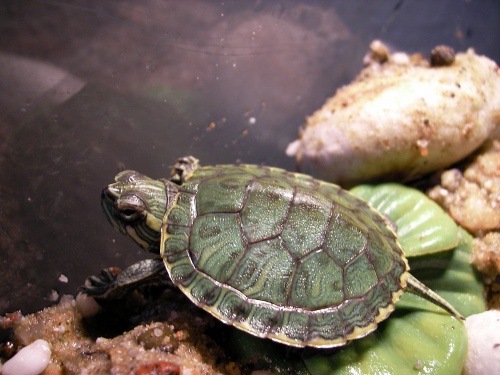The red-eared slider is a medium-sized freshwater turtle species native to the south-central United States. With olive to brown-colored shells and yellow stripes, these turtles have a yellow plastron with dark spots in the center of each shell plate.
Red-eared sliders are known for being opportunistic foragers that consume small fish, crayfish, aquatic plants, and various aquatic invertebrates. Found in the Midwestern states, they have also been introduced worldwide as an invasive species.

Credit: nas.er.usgs.gov
Introduction To Red-eared Sliders
The red-eared slider is a medium-sized freshwater turtle native to the south-central United States. It has an olive to brown top shell with yellow stripes and a yellow bottom shell with dark spots. Known for its opportunistic feeding habits, it consumes small fish, crayfish, aquatic plants, and invertebrates.
Description Of Red-eared Slider
Red-eared sliders are medium-sized freshwater turtles known for their distinct appearance. These turtles have an olive to brown top shell (carapace) and skin, adorned with vibrant yellow stripes that make them easily recognizable. Their bottom shell (plastron) is typically yellow, although it can sometimes have a brownish-orange hue. Interestingly, each shell plate, or scute, on the plastron features dark spots at its center, adding to the turtle’s unique pattern. With their eye-catching colors and markings, red-eared sliders are sure to captivate any observer’s attention.Classification Of Red-eared Slider
Red-eared sliders belong to the genus Trachemys, which is a part of the family Emydidae. This genus includes turtles native to the Americas, ranging from the Midwestern United States all the way down to northern Argentina. However, one subspecies of Trachemys, namely the red-eared slider (Trachemys scripta elegans), has gained global popularity and has been introduced in various parts of the world. These medium-sized freshwater turtles are renowned for their adaptability and can be found in various habitats, including ponds, lakes, and rivers. Their worldwide presence makes them a captivating subject for turtle enthusiasts and researchers alike.
Credit: bellavistapoa.com
Habitat And Distribution
The Red-eared Slider is a medium-sized freshwater turtle that is native to the south-central United States. They can be found in various habitats, including ponds, lakes, rivers, and marshes. These turtles are well-adapted to both still and slow-moving water bodies. They prefer habitats with ample vegetation and basking spots, such as logs or rocks, where they can regulate their body temperature.
Origin Of Red-eared Slider
The red-eared slider is native to the south-central U.S., covering the Midwestern states and extending east to West Virginia and west to New Mexico. They can also be found as far south as northeastern Mexico and in much of the Mississippi River basin. The natural range of the red-eared slider includes both terrestrial and aquatic habitats with access to water bodies.
Invasiveness Of Red-eared Sliders
The red-eared slider, specifically the subspecies Trachemys scripta elegans, has been introduced worldwide and is considered an invasive species in many areas. Due to its adaptability and ability to reproduce quickly, the red-eared slider is known to outcompete native species for resources and disrupt local ecosystems. Its high reproductive rate and ability to tolerate a wide range of habitats contribute to its invasiveness.
Behavior And Diet
Red-Eared Sliders, a species of medium-sized freshwater turtles, have olive to brown top shells with yellow stripes and yellow or brownish orange bottom shells. They are native to the south-central United States but have been introduced worldwide. They are opportunistic foragers, consuming small fish, crayfish, aquatic plants, and various aquatic invertebrates.
Characteristics Of Red-eared Sliders
Red-eared sliders are medium-sized freshwater turtles with olive to brown skin and yellow stripes. They have a top shell called carapace and a bottom shell called plastron. The plastron is usually yellow but can sometimes be brownish orange, with dark spots in the center of each shell plate. These turtles belong to the genus Trachemys and are native to the south-central United States. While they have been introduced worldwide, their natural habitat extends from the Midwestern states to West Virginia, New Mexico, and northeastern Mexico. Red-eared sliders are classified as reptiles and are known for their distinct appearance and adaptability.Feeding Habits Of Red-eared Sliders
Red-eared sliders are opportunistic foragers with a varied diet. In their natural habitat, they consume small fish, crayfish, aquatic plants, and various aquatic invertebrates such as insects, worms, shrimp, snails, and even amphibians. They are also known to eat dead material. These turtles are capable of adjusting their feeding habits according to the availability of food. In captivity, red-eared sliders are commonly fed on a balanced diet of commercially available turtle pellets, leafy greens, vegetables, and occasional proteins such as fish or insects. It is important to provide them with a diverse diet to ensure their nutritional needs are met. Regular feeding and appropriate portion control are crucial to maintaining the health and well-being of red-eared sliders.| Preferred Diet | Avoid |
|---|---|
|
|
In Summary
Red-eared sliders are medium-sized freshwater turtles native to the south-central United States. They have distinct characteristics, including an olive to brown skin color with yellow stripes and a yellow or brownish orange bottom shell with dark spots. These turtles are adaptable and have been introduced to various regions worldwide. When it comes to their feeding habits, red-eared sliders are opportunistic foragers, consuming a variety of food such as small fish, crayfish, aquatic plants, and aquatic invertebrates. In captivity, it is important to provide these turtles with a diverse diet consisting of commercially available turtle pellets, leafy greens, vegetables, and occasional proteins. Avoiding foods high in fat or sugar and ensuring proper portion control is essential for their overall health and well-being.
Credit: bellavistapoa.com
Frequently Asked Questions For Red-eared Slider: Species Profile
What Are The Characteristics Of A Red-eared Slider Turtle?
Red-eared sliders are medium-sized freshwater turtles with olive to brown top shells and yellow stripes. Their bottom shells are typically yellow with dark spots. They are native to the south-central U. S. and can be found in the Midwestern states, West Virginia, New Mexico, and northeastern Mexico.
What Is The Classification Of A Red-eared Slider Turtle?
The red-eared slider turtle is classified as a reptile. It is a medium-sized freshwater turtle with olive to brown top shell and yellow stripes. Its bottom shell is usually yellow with dark spots. It is native to the south-central U.
S. and has been introduced worldwide.
Where Did The Red-eared Slider Originate?
The red-eared slider originated in the south-central United States, including states in the Midwest, West Virginia, New Mexico, and parts of northeastern Mexico. It is also found in the Mississippi River basin.
Are Red-eared Sliders Invasive?
Yes, red-eared sliders are considered invasive. They have been introduced worldwide and may compete with native turtle species.
Conclusion
The red-eared slider turtle is a fascinating species with unique characteristics. As a medium-sized freshwater turtle native to the south-central United States, they have olive to brown-colored shells with yellow stripes and a yellow or brownish orange bottom shell. They can be found in various parts of the U.
S. And Mexico, making them an interesting and diverse species. Their diet consists of small fish, crayfish, aquatic plants, and invertebrates, showcasing their opportunistic foraging nature. Overall, the red-eared slider turtle is a captivating creature with its vibrant appearance and adaptable behavior.


